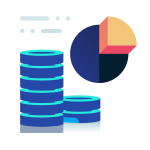What is what in Forex
When you are just taking your first steps with Forex trading you will come across quite a lot of terms you don’t understand. In fact, after having them explained to you, you’ll find it hard to understand them. I have experienced it on myself when I first started learning Forex trading and let me tell you it was truly overwhelming. You start learning it, you get a feeling that yes, finally I fully understand it but then you apply them to your trades and get confused again. Leverage, pips, hedging, swaps – what are you talking about?!
For beginner traders, it can be really confusing and even bothering but do not worry, I will let you know what the main terms of Forex mean, how do they work and what is an essential Forex glossary you need to have in your dictionary as a trader. These terms are very important to know because if you do not understand it completely there is a very low chance for you to be good at Forex trading. As always, I will give as many examples as I can to make it more understandable for you.
 Spread
Spread
To understand what Forex spread is you should understand how Forex trading works. Let’s say you know that the price of a certain product will rise, for example, a house. You are buying a house to sell it after some time when the time comes, you will not sell the house with the same price you purchased it. You will sell it more expensively, otherwise what’s the meaning of buying and selling it. If you bought the house for $50.000, and the value of it was raised up to $55.000 it will be the minimum you would sell the house for, If the customer is ready to buy the house for $57.000 it will be the maximum value of it. The difference between the price when you are ready to sell the house for and the highest price the buyer is willing to pay for it is spread.
Let’s see how Forex spread works. When you are trading you are receiving a quote from the broker. The quote contains two prices, the sell price (called ask price ) and the buying price (called bid). The difference between these prices is spread. To put it simply, a bid is the highest price the trader is willing to pay and sell price is the lowest that the broker is willing to accept. When you are trading you would want to search for tight spreads. Some brokers make money thought the spreads and are referred to as spread brokers.
Pip
Spreads are usually quoted with pips, but what is a pip in Forex? It is an acronym for Percentage In Point. Let’s see an example for more clarity. Say you are trading Forex and you trade the EUR/USD currency pair. This currency pair represents the relationship between these two currencies, in this pair EUR is a base currency and the USD is a quoted currency, in other words, this pair shows how many USD you need to purchase a single EURO. Usually, currency pairs are priced to four decimal places, in this the smallest change is the last decimal point (the fourth one) and it is a pip.
So pip is the smallest price move in an exchange rate. If the exchange rate of EUR/USD is 1.1300 and it increases to 1.1305, it means that the change is 5 pips.
Lot
As you could see from the examples of pips, the changes in the exchange rate is small, in order to make considerable amounts of profit, the particular currency pairs are traded in large quantities. Meaning that not 5 or 10 units of the currency are traded, but hundreds, thousands and even millions. The lot is a specific amount of currency units sold or bought. Some brokers still show the amount in real units, but usually, with the majority of the brokers, you will see the units shown as lots. There are four different lot sizes. Standard, mini, macro and, nano. When it is standard, 1 lot means that the unit of the currency traded is 100.000. The number of units in the mini lot is 10.000 in macro 1000 and in nano 100. If you want to trade the EUR/USD currency pair standard lot, it means you are trading 100.000 currency units.
 Leverage
Leverage
The next term in our Forex dictionary is leverage. You would see this word a lot in the Forex industry.
Let’s go back to our first example, you want to buy the house which costs $50.000 to sell it later and gain profit from it. However, you do not have that much money, you only have $5,000. To make your investment you borrow $45.000 from someone else.
Borrowing the money to invest in something works the same way in Forex trading. The broker is someone that is giving you the money through leverage. Leverage makes it possible for the trader to control a huge amount of the capital to invest only with the money that he has on a trading account.
The leverage can be different based on the broker. All brokerages have set maximum leverage, for example, 1:100, meaning that you can multiply your initial deposit by a hundred. You do not have to take the highest leverage as the trader is allowed to choose the leverage he needs by himself.
Leverages are different for different assets, usually, stocks, bonds, indices, commodities, and cryptocurrencies have low leverage, while Forex has the highest. This is the reason why many traders choose to trade Forex.
 Margin
Margin
The leverage works with margin. Let’s say you want to make a trade that requires $50,000, just like the house you wanted to buy. The broker offers you a 1:100 leverage. To use the leverage you need to have a margin, the margin is usually from 0.5 to 2 percent of the requested amount. Meaning that if you want to start a trade for $50.000 you need to deposit 1 percent of it on your account, which is $500.
The broker will add up 99% of the money and you will be able to make a trade with $50.000.
If the broker will see that your trading position is worsened and the loss is approaching your initial deposit $500, the broker might initiate the margin call. It is when the broker demands from the investor to deposit more money or close the position so that both parties minimize the risks. However, this might not happen hence you need to be very careful and attentive, especially when trading with margin/leverage.
Liquidity
Liquidity meaning in Forex is the same as what liquidity would mean in any other industry. If you bought a house and want to sell it now, but nobody wants to buy it – this house has a low level of liquidity. In Forex, the easier it is to sell a currency, the higher the liquidity it has. Hence, most liquid Forex pairs are the ones that are often traded. These pairs include the major currency pairs (pairs that have USD on one side and major currency on the other.) The most liquid currency pair is EUR/USD.
Volatility
As the EUR/USD currency pair is the most liquid, it has less volatility. So what is volatility? Volatility means that the price of the currency can change dramatically in a very short period of time. It is not expected that EUR value will be increased or decreased significantly, the same goes for the USD. However, some currencies in the world can be changed in a very short time. Volatility shows the risk or the amount of uncertainty that is involved with the size of changes in a currency exchange rate. If you buy 1 standard lot of EUR/USD you can be sure that the price will not change a lot and you can calculate your profits based on it. However, if you trade with a currency pair that is more volatile you cannot be sure what will happen. Due to this, high volatility usually attracts to the day traders, as they can make more profit with it.
Position
A position is called to a trade that you hold open during a certain period of time. So the trade that is active is a position. You can take a long position or a short position, however, it is not quite the same what the word suggests it could be. As I have mentioned in the currency pairs segment, the first currency is a base currency and the second one is a quote currency. In the EUR/USD pair, EUR is a base currency and USD is a quote currency. Entering a long position (going long) means that you buy a base currency, in this case, EUR.
In this situation you think that the EUR will strengthen compared to the USD, therefore you are buying EUR to make a profit once the value of it will be increased – in other words with this decision you are entering a long position.
A short position (going short) is the opposite of it. Instead of buying a base currency you are selling it because you expect that the euro will weaken compared to the USD. Hence, you will make the profit from the decrease in the value of EUR.
When you are entering a long position and you see that the base currency has really increased you would like to get your profit from it, to do so you must close the position you are holding. When you do so, the profits will appear on your trading account.
Order Types
There are several types of orders you can make while trading Forex.
Market order/Market entry: When you give this type of order, you buy or sell the currency at the price which is valid for the exact moment you placed the order.
Open order: Open order is to buy or sell currency or any other financial instrument that can be traded. This type of order will be open until you close it, meaning that you can observe how the market changes and close it once it is most profitable for you. Also, you may have your broker close the open trade for you.
Limit order: placing limit order helps you set the limit to the price, at which you want to sell. For example, you are trading with EUR/USD, you are expecting it to raise from 1.13 to 1.14. You place the limit on 1.14 and once the price increases at 1.14 you will go short.
Stop-entry order: It is the opposite of the above. If you want to buy the currency when the price will reach a certain number you go long.
Take profit order: with this type of the order, you are able to set the limit not on the currency price itself, but on your profits. As soon as your trade reaches a certain level of profit, the position will be closed.
Stop-loss order: this type of order is the opposite of the take profit order. You set the limit not on the profits that you want to get from the trade, but on the loss that you can bear. This order gives you the possibility to minimize your loss as it closes once it reaches a certain level. With this strategy, you can avoid losing your capital.
Swaps/Rollovers
As we already know, Forex is traded in currency pairs. Each pair includes two different currencies and each of them has a different interest rate. When exchanging currencies you basically buy them and sell them. Based on the interest rates the rollover can be positive or negative.
Let’s say you bought a currency that has a higher interest rate than the currency that you sold. It means that you earn the interest, which is the difference between the interests of these currencies. It is called a positive roll.
If it happened the other way, meaning that the currency you bought has a lower interest rate than the one you sold, it means your rollover is negative, and you need to pay the difference between these currency rates.
As you can see the rollover can have a significant effect on the cost or profit, the amount of the rollover increases or decreases depending on the increase or decrease of the position size.
Hedging
The best way to understand what hedging is to think of insurance. If you buy a house for $50.000 and plan to sell it once the price will go up, you would want to make sure that nothing will affect the price of the house in a negative way. Hence, you might buy insurance. Although the insurance cannot give you 100 percent safety and moreover, it cannot grant you that nothing bad will happen to your house, it helps minimize the risk.
So what is hedging in Forex? It is a way to reduce potential loss. The hedging technique is rather simple, when you open a new position you also open a position in the opposite direction of the first position, on the same instrument. Let’s go back to the EUR/USD currency pair example, if you go long with the first position, you do hedging and open the opposite position – go short. Obviously, nothing can give you hundred percent guarantee that you will make a profit, neither can hedging, however it will help you reduce your loss, therefore this word should definitely be in your Forex dictionary. In order to hedge a position, there is no additional margin required, however you should have sufficient usable margin on your trading account to open a new position.
 Bottom line
Bottom line
These are the Forex basic terminologies that you absolutely need to know when you start trading. However, knowing them is hard enough to be a good trader or to trade profitably. To do so you will need to learn a lot more and will be presented to many and more complex terms. But do not get discouraged as once you start learning these terms, they will become an inseparable part of your Forex dictionary.














Comments (0 comment(s))